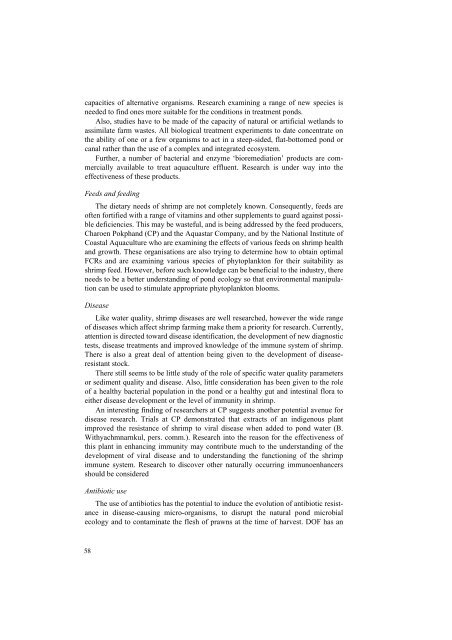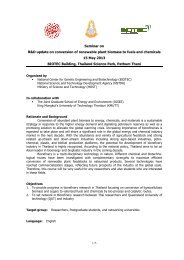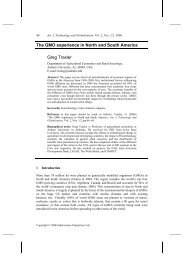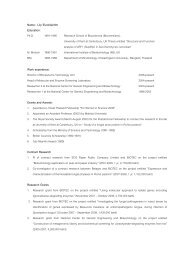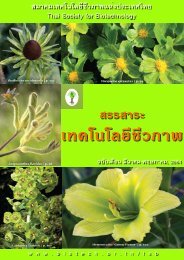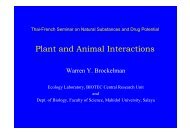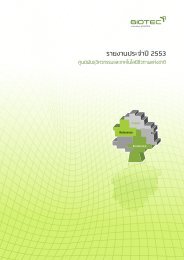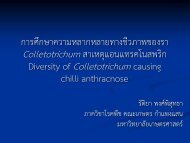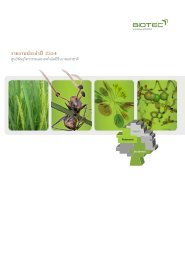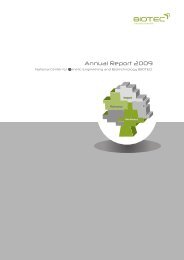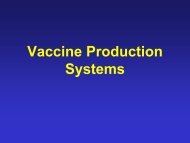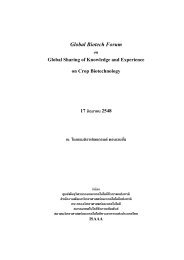Coastal Shrimp Aquaculture in Thailand: Key Issues for Research
Coastal Shrimp Aquaculture in Thailand: Key Issues for Research
Coastal Shrimp Aquaculture in Thailand: Key Issues for Research
Create successful ePaper yourself
Turn your PDF publications into a flip-book with our unique Google optimized e-Paper software.
capacities of alternative organisms. <strong>Research</strong> exam<strong>in</strong><strong>in</strong>g a range of new species isneeded to f<strong>in</strong>d ones more suitable <strong>for</strong> the conditions <strong>in</strong> treatment ponds.Also, studies have to be made of the capacity of natural or artificial wetlands toassimilate farm wastes. All biological treatment experiments to date concentrate onthe ability of one or a few organisms to act <strong>in</strong> a steep-sided, flat-bottomed pond orcanal rather than the use of a complex and <strong>in</strong>tegrated ecosystem.Further, a number of bacterial and enzyme ‘bioremediation’ products are commerciallyavailable to treat aquaculture effluent. <strong>Research</strong> is under way <strong>in</strong>to theeffectiveness of these products.Feeds and feed<strong>in</strong>gThe dietary needs of shrimp are not completely known. Consequently, feeds areoften <strong>for</strong>tified with a range of vitam<strong>in</strong>s and other supplements to guard aga<strong>in</strong>st possibledeficiencies. This may be wasteful, and is be<strong>in</strong>g addressed by the feed producers,Charoen Pokphand (CP) and the Aquastar Company, and by the National Institute of<strong>Coastal</strong> <strong>Aquaculture</strong> who are exam<strong>in</strong><strong>in</strong>g the effects of various feeds on shrimp healthand growth. These organisations are also try<strong>in</strong>g to determ<strong>in</strong>e how to obta<strong>in</strong> optimalFCRs and are exam<strong>in</strong><strong>in</strong>g various species of phytoplankton <strong>for</strong> their suitability asshrimp feed. However, be<strong>for</strong>e such knowledge can be beneficial to the <strong>in</strong>dustry, thereneeds to be a better understand<strong>in</strong>g of pond ecology so that environmental manipulationcan be used to stimulate appropriate phytoplankton blooms.DiseaseLike water quality, shrimp diseases are well researched, however the wide rangeof diseases which affect shrimp farm<strong>in</strong>g make them a priority <strong>for</strong> research. Currently,attention is directed toward disease identification, the development of new diagnostictests, disease treatments and improved knowledge of the immune system of shrimp.There is also a great deal of attention be<strong>in</strong>g given to the development of diseaseresistantstock.There still seems to be little study of the role of specific water quality parametersor sediment quality and disease. Also, little consideration has been given to the roleof a healthy bacterial population <strong>in</strong> the pond or a healthy gut and <strong>in</strong>test<strong>in</strong>al flora toeither disease development or the level of immunity <strong>in</strong> shrimp.An <strong>in</strong>terest<strong>in</strong>g f<strong>in</strong>d<strong>in</strong>g of researchers at CP suggests another potential avenue <strong>for</strong>disease research. Trials at CP demonstrated that extracts of an <strong>in</strong>digenous plantimproved the resistance of shrimp to viral disease when added to pond water (B.Withyachmnarnkul, pers. comm.). <strong>Research</strong> <strong>in</strong>to the reason <strong>for</strong> the effectiveness ofthis plant <strong>in</strong> enhanc<strong>in</strong>g immunity may contribute much to the understand<strong>in</strong>g of thedevelopment of viral disease and to understand<strong>in</strong>g the function<strong>in</strong>g of the shrimpimmune system. <strong>Research</strong> to discover other naturally occurr<strong>in</strong>g immunoenhancersshould be consideredAntibiotic useThe use of antibiotics has the potential to <strong>in</strong>duce the evolution of antibiotic resistance<strong>in</strong> disease-caus<strong>in</strong>g micro-organisms, to disrupt the natural pond microbialecology and to contam<strong>in</strong>ate the flesh of prawns at the time of harvest. DOF has an$'


